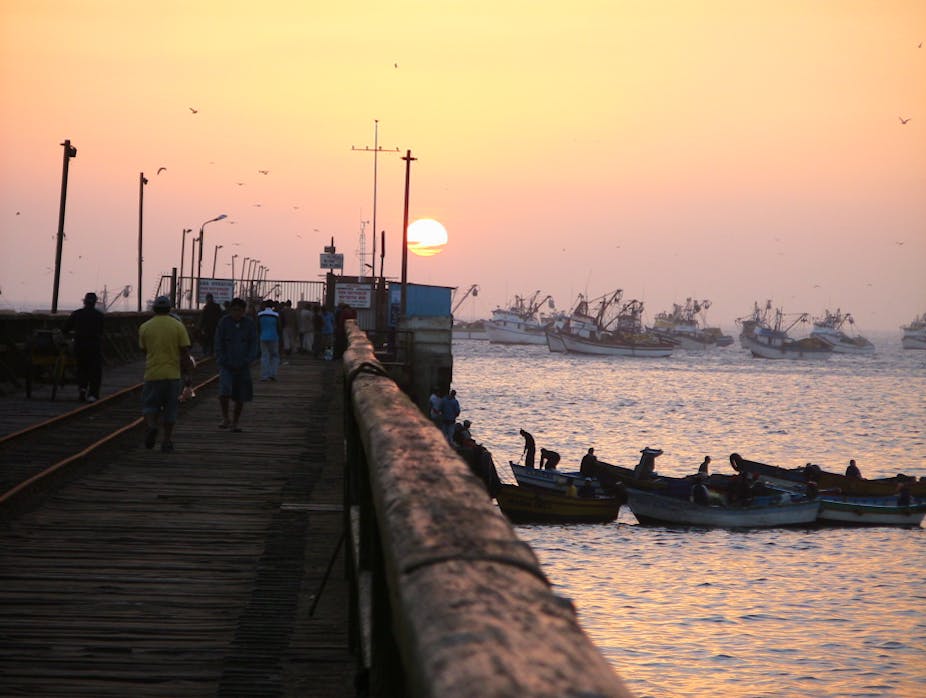Many fisheries around the world are in bad shape and getting worse. Solving this problem will require innovative monitoring and management tools, but we can provide tremendous benefits if we act now to reverse our course. Taking a serious, in-depth look at fisheries could help feed the world’s growing population, and conserve marine species.
Humanity is reaching farther and deeper into the oceans and, until recently, there were only anecdotes and guesses about the complete effects of our actions. Our team has developed a new method, recently published in the journal Science, that uses simple data to understand the state of thousands of fisheries that until now have never had their population levels assessed. While many of the world’s largest fisheries have population assessments, the world’s “unassessed” fisheries make up the majority of the species diversity and volume of the world’s catch.
The current condition
Large fisheries with assessed populations appear to to be in relatively good shape. But, our results show that unassessed fisheries are in poor condition and getting worse. Sixty-four percent of the unassessed fisheries in our study could provide higher yields and more fish in the water if they were rebuilt. While we estimate that only 18% of the fisheries in our study have severely depleted populations, the trend shows that many more fisheries may reach this dangerous level.
This story holds true in both the developing and developed world. But, some types of fisheries are doing far worse than others. Slow growing, large species like sharks are in especially bad shape, while small schooling species like sardines are in far better condition.
The most striking difference is between small-scale and large-scale fisheries. Small unassessed fisheries are very depleted, while the group of large fisheries are doing relatively well (but like the small, trending downwards).

Benefits and barriers to rebuilding
The path we are on will damage marine ecosystems, food security, and the huge array of other services the oceans provide. These effects could be especially severe considering the potential impacts of climate change and the skyrocketing need for seafood.
But, changing course and rebuilding global fisheries could result in a 56% increase in biomass of live fish in the water. We could at the same time achieve a 40% increase in catch relative to the catches that business-as-usual fishing will leave us.
There are two fundamental barriers to rebuilding fisheries and achieving these substantial benefits: the difficulty of assessing fish populations and the economic incentives driving overfishing. The most commonly used tools to assess fish populations, while often very effective, require large amounts of money and scientific expertise. This makes them impractical for many regions of the world.
Additionally, many fisheries fail to provide economic incentives for sustainability. These often operate under “racing” conditions, where fishers have little choice but to compete to quickly catch as much fish as possible. The lack of sustainability incentive this creates, combined with the challenges of monitoring fish populations, has led to the depleted levels now seen in many fisheries.
There are solutions
The challenge is how to overcome these barriers and rebuild depleted fisheries.
There have been many recent innovations in cheaper, simpler ways to monitor fish populations. While these simple assessments don’t give the detail of a traditional assessment, they provide a way for fisheries with limited resources to assess population levels and make informed management choices. These simple assessment tools can help make effective monitoring possible for many more of the world’s fisheries.
While these simple assessment methods can help answer the question of how many fish are in the water, they don’t address the incentives that lead to overfishing in the first place. Economic tools - commonly called rights-based management (RBM) - can help solve this problem. The idea behind RBM is that giving fishers a stake in the future of their fisheries promotes sustainable practices. In a diverse group of fisheries where they have been tried, these RBM approaches have helped rebuild depleted fisheries and provide better livings for fishermen.
There are also gains to be made from the consumer side of the equation. Developing and improving ways to identify sustainable seafood can help reward responsible fishing and allow consumers to make informed decisions.
What’s next?
The old idea that fisheries are inexhaustible has clearly been proven false. But it is also incorrect to think that fisheries are doomed.
While there is still a lot to learn, we now have the clearest picture we have ever had of the world’s diverse fisheries. The depleted states and declining trajectories coming into focus are serious problems. But, there’s also a lot to be hopeful about.
We’ve seen that putting the right monitoring and management in place can rebuild fisheries. Tools like simple population assessments and economic incentives can make sustainable fisheries a reality for communities around the globe. There is still time to put these solutions into place, but the seas are getting rough.
Read more on sustainable fisheries.


